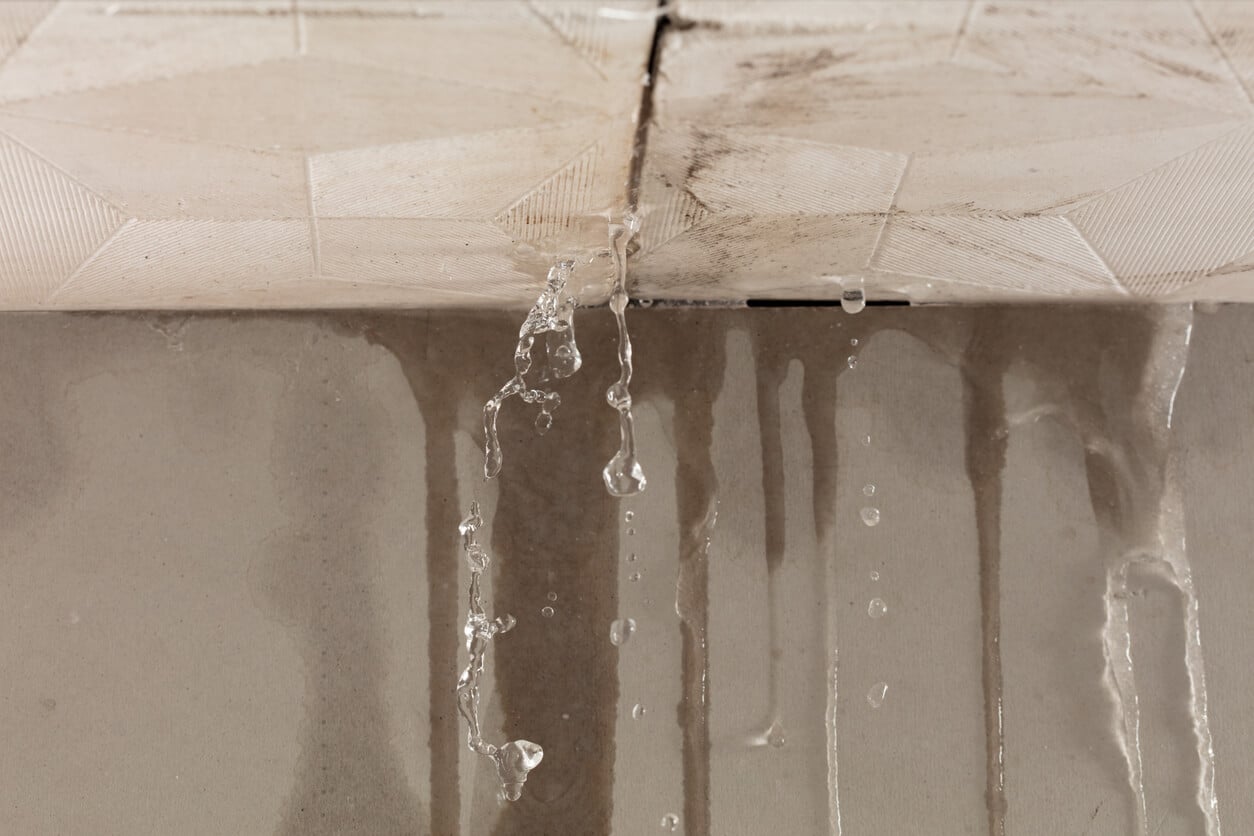
The storm hit hard last night. Wind howled through the trees, rain hammered the roof, and as you finally drifted off to sleep, you hoped everything would hold.
But this morning? A damp ceiling. A drip in the hallway. A slow-growing stain above your kitchen light.
Now, panic sets in. You don’t have time to wait or risk hiring the wrong contractor. You need real help, right now. Someone who will show up, find the source, and fix the leak, not pressure you into a costly replacement you didn’t plan for.
That’s where Mr. Roofer comes in. We’re not just another name in your “leaking roof repair near me” search. We’re Atlanta’s leak repair specialists. With deep experience in storm damage, old homes, and tricky flat roofs, we know how to stop water in its tracks and bring back your peace of mind.
Fast. Honest. Local. When the weather calms, let us be the ones who help you put it all back together.
What Causes Roof Leaks in Atlanta Homes?
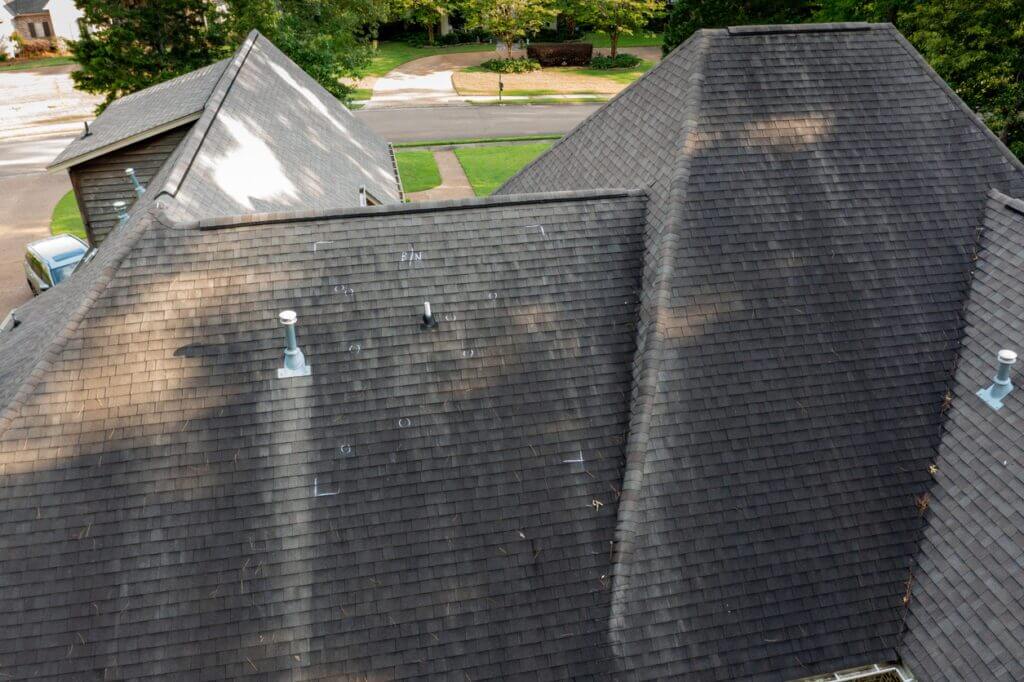
A leaking roof is more than just an inconvenience. It’s a signal that something above your head needs urgent attention. In metro Atlanta, leaks often follow heavy storms, extreme humidity, or the natural aging of roofing systems. Here’s a breakdown of the most common culprits behind roof leaks in our area.
Age and Wear of Roofing Materials (Especially Homes 40-80+ Years Old)
Atlanta’s historic neighborhoods, like Decatur, Grant Park, and Druid Hills, are full of charm, but many of the roofs haven’t seen proper updates in decades. Asphalt shingles naturally degrade over time, and older roofs may be missing underlayment, modern flashing, or proper ventilation. As materials weaken and become brittle, even small issues can let water in.
If your home is 40 years or older and hasn’t had a full roofing evaluation recently, chances are, it’s due.
Storm Damage (Hail, High Winds, Tree Debris)
Atlanta weather is no joke. Sudden thunderstorms, strong winds, and the occasional hailstorm can wreak havoc on your roof. Shingles can lift, crack, or blow off entirely. Tree branches may scrape or puncture roofing materials, leaving vulnerabilities behind. Often, homeowners don’t realize there’s damage until the next rainstorm reveals it with an indoor leak.
After a major weather event, it’s always wise to have a professional inspection—even if you don’t see immediate damage.
Clogged Gutters and Poor Roof Drainage
If your gutters are overflowing, sagging, or clogged with leaves, rainwater has nowhere to go. Instead, it can back up under the shingles or spill over fascia boards, eventually seeping into the home. In some cases, clogged downspouts can even lead to standing water on flat sections of the roof, setting the stage for a leak.
Proper drainage is your roof’s best defense. Keeping gutters clean (or installing gutter guards) is a small step that prevents big problems.
Flashing Failure, Nail Pops, or Chimney Issues
Flashings are thin metal strips designed to direct water away from chimneys, vent pipes, skylights, and roof valleys. Over time, these metal components can rust, shift, or detach. Nail pops, caused by natural expansion and contraction, can also push shingles up and expose vulnerable areas. And aging brick chimneys with crumbling mortar can become prime sources of water infiltration.
Because these areas are small but critical, they often require a trained eye to catch and repair before leaks spread.
Flat Roof-Specific Problems: Ponding Water, Seam Splits, HVAC Curb Leaks
Flat roofs are common on modern homes, additions, and commercial buildings in Atlanta, but they bring unique challenges. Water doesn’t shed as easily as it does on sloped roofs, leading to ponding (standing water). Over time, this can cause membrane deterioration, seam separation, or leaks around HVAC curbs and vents.
If your flat roof has drainage issues or persistent puddles after rainfall, it’s a red flag. The sooner it’s addressed, the better.
Common Signs You Need Roof Leak Repair
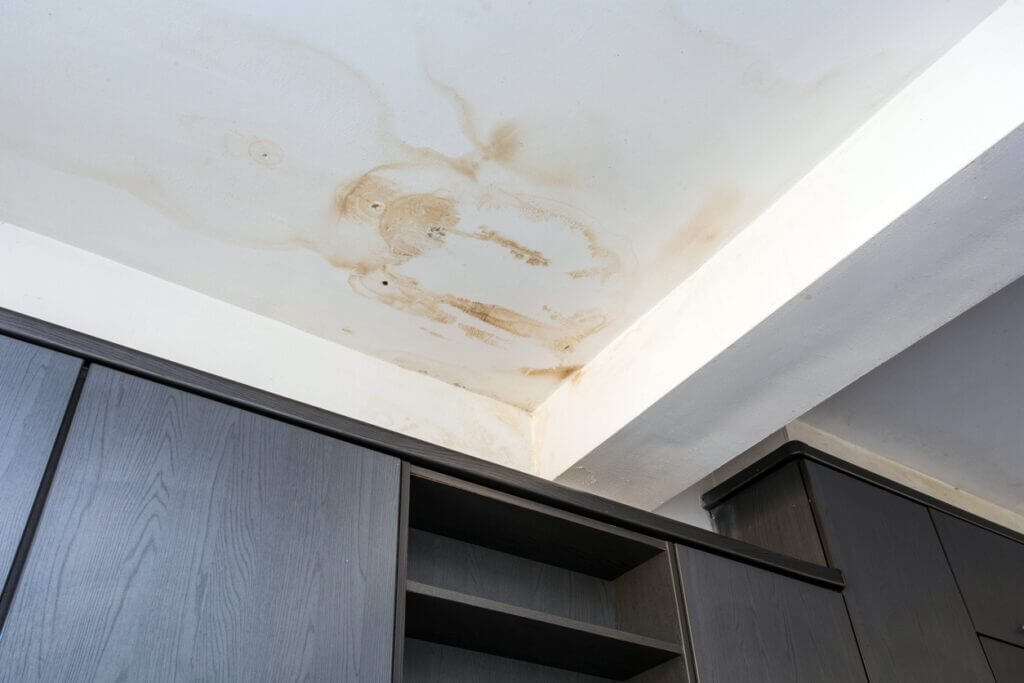
Roof leaks rarely start with a dramatic drip from the ceiling. Often, the signs are subtle and easy to ignore until serious damage is done. If you’re seeing (or smelling) any of the following issues inside or outside your home, it’s time to call in a trusted local expert like Mr. Roofer.
Interior Warning Signs
Sometimes, your roof leak will reveal itself indoors long before you see any shingle damage. These clues often show up in the ceiling, walls, or attic, especially after a heavy Atlanta rain.
Ceiling Stains
Brown or yellow discoloration on ceilings or upper walls is a telltale sign of water intrusion. These stains may start small but can quickly spread as more rain enters your home.
Musty Odors
That damp, earthy smell you can’t quite place? It could be water soaking into insulation or drywall. If certain rooms or attic areas consistently smell musty, water may be getting in undetected.
Mold Growth
Mold thrives in dark, moist environments, and a roof leak creates the perfect breeding ground. You might spot black or green growth on ceilings, walls, or even behind furniture.
Dripping or Water Running Down Walls
If you’re seeing or hearing water during a rainstorm, the problem is already severe. This usually means the water barrier has completely failed, and immediate repair is critical.
Exterior Warning Signs
While some roof issues reveal themselves indoors, many are visible right from your yard or driveway, if you know what to look for. Here are a few red flags Atlanta homeowners should watch for, especially after storms.
Missing Shingles
High winds and falling debris can lift or tear off shingles, leaving your roof exposed. Even a single missing shingle can let water in and lead to widespread damage.
Exposed Underlayment
If you can see the black or synthetic layer beneath your shingles, it means the top layer has been compromised. This is often a sign of wind damage or aging materials breaking down.
Rusted or Loose Flashing
Look around your chimney, vent pipes, and roof valleys. If the metal flashing is rusted, detached, or out of place, water can sneak into these vulnerable joints and seams.
Clogged Valleys
Roof valleys, where two roof slopes meet, are designed to channel water off your roof. But if they’re filled with leaves, pine needles, or debris, water can back up and seep under the shingles.
Water Pooling on Flat Roof Surfaces
Flat or low-slope roofs are especially prone to ponding water, which breaks down roofing membranes over time. If puddles remain more than 48 hours after rain, it’s time to call for a roof inspection.
How to Search Smart: “Roof Leak Repair Near Me” vs. Just Googling a Roofer

When your ceiling starts dripping or a mysterious brown stain appears after a storm, your first instinct is probably to search “roof leak repair near me.” That’s a smart move, but choosing just any roofer off Google results isn’t always the best path forward. Here’s why being intentional with your search (and your choice) makes all the difference.
Why Leak Repair Is a Specialized Service—Not All Roofers Focus On It
Many roofing companies in metro Atlanta focus almost exclusively on full roof replacements. Why? Because replacements are more profitable and more straightforward to estimate. Leak repairs, on the other hand, require investigative skill, precision, and a willingness to troubleshoot hard-to-find issues in older or storm-damaged systems.
If a roofer seems too eager to push a full replacement before thoroughly evaluating your issue, that’s a red flag. True repair specialists take the time to diagnose the problem and fix what’s fixable, without unnecessarily upselling.
The Importance of Local Expertise
Atlanta’s climate, architecture, and building materials are unique. From the historic homes of East Point to the flat roofs of Midtown, no two roof systems are quite the same. That’s why hiring a roofer with local knowledge is so important.
A qualified local expert understands:
- How Georgia’s humidity and heavy summer rains affect aging shingles
- How to work around dense tree coverage and gutter clog risks
- What materials were used in homes built in the 1940s vs. the 1990s
- And how code requirements vary across Atlanta’s different counties
Choosing a local repair specialist helps ensure the work is both effective and up to standard.
What Makes Mr. Roofer Different
At Mr. Roofer, we’ve built our reputation on being repair-first, especially when others walk away from “difficult” jobs.
70% of Jobs Are Repairs, Not Replacements
Unlike most companies, leak repair is at the core of what we do. In fact, over 70% of our projects involve repairing existing roofs, not replacing them outright. We believe in restoring value where possible and saving homeowners money in the process.
Expertise in Old Roofs, Cedar Shake, Flat Roofing, and More
Whether your roof is 80 years old, covered in cedar shake, or part of a tricky flat-roof system over a sunroom or addition, we’ve seen and fixed it all. Our team knows how to preserve character while solving the leak, using both traditional methods and modern materials tailored to your exact situation.
Understanding the Types of Leak Repairs
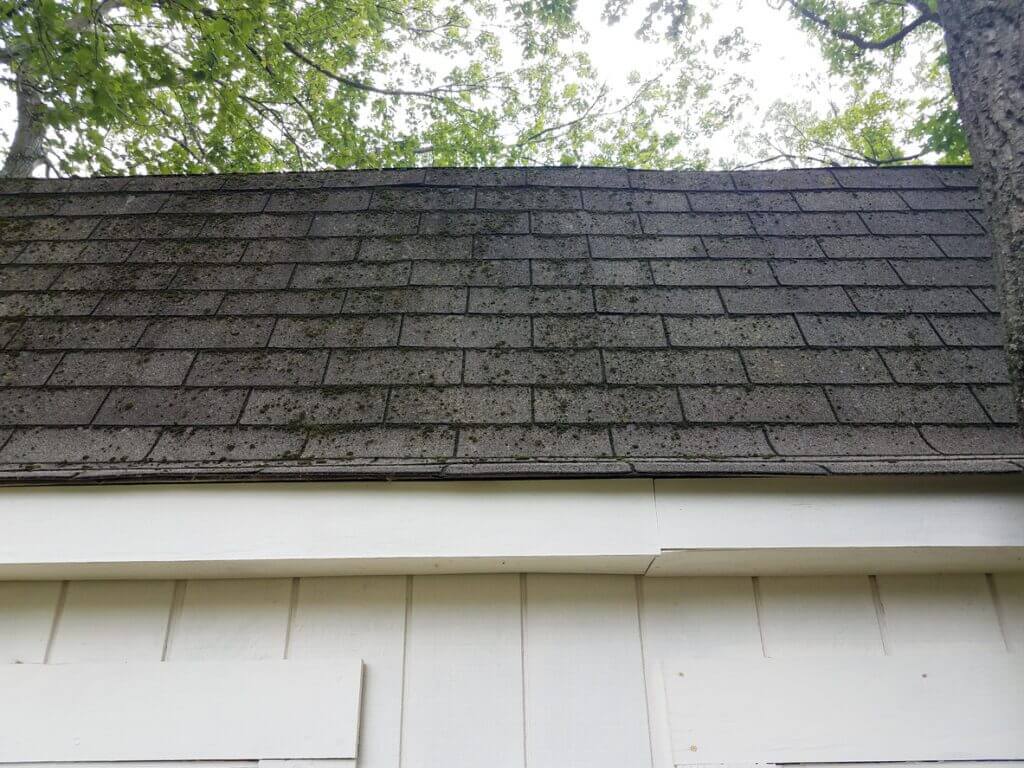
Not all roof leaks are created equal, and neither are the repairs. Depending on your roof type, age, and the source of the problem, the right fix could be as simple as a shingle replacement or as complex as reworking a flat roof’s drainage system. Here’s what you need to know when searching “roof leak repair near me” in Atlanta.
Leaky Roof Repair Near Me: General Patching, Flashing Fixes, Shingle Replacement
Most pitched residential roofs in Atlanta are covered in asphalt shingles. Over time, shingles can crack, curl, blow off, or loosen, especially after storms. In many cases, small leaks are caused by just a handful of damaged shingles or faulty flashing around chimneys, skylights, or vents.
Common pitched roof repairs include:
- Shingle replacement: Matching and installing new shingles to restore protection
- Flashing repair or replacement: Sealing gaps around penetrations or valleys
- Roof cement or patching: Sealing minor holes or exposed nail heads
- Underlayment patching: Replacing water-damaged felt beneath shingles
These repairs are often fast, affordable, and highly effective when done by a trained eye that can properly trace the leak to its true source.
Flat Roof Leak Repair Near Me: Sealing Seams, Membrane Recoating, Correcting Ponding
Flat and low-slope roofs are common in Atlanta’s mid-century homes, modern renovations, and commercial properties. While flat roofs look sleek, they present unique leak risks, including pooling water, membrane wear, and improper drainage.
Flat roof repairs may include:
- Sealing or welding open seams in TPO, EPDM, or modified bitumen membranes
- Recoating the surface with elastomeric or silicone roof coatings to extend life
- Re-sloping problem areas with tapered insulation or patch systems to eliminate ponding
- Addressing HVAC curb leaks, drain clogs, or flashing breakdowns around penetrations
These systems require a roofer who knows how to handle flat roof materials and identify subtle signs of failure before they escalate.
Roof Patching Near Me: When and Where Patching Makes Sense (And When It Doesn’t)
“Roof patching” might sound like a quick fix, and sometimes, it is. But it’s not always the right long-term solution. The key is knowing where, when, and how to patch in a way that stops the leak without compromising the rest of your roof.
Roof patching makes sense when:
- The damage is localized and hasn’t spread
- The underlying structure is still sound
- Matching materials are available
- You need a temporary fix before a full replacement later
Roof patching may not work when:
- The roof is past its service life
- The leak is widespread or from multiple sources
- Structural decking is rotted or compromised
- The same area has already been patched multiple times
How Much Does Roof Leak Repair Cost in Atlanta?
Cost is one of the first questions homeowners ask, and understandably so. But while it’s tempting to search “cheap roof leak repair near me,” quality leak repair is about more than price. It’s about stopping the water intrusion correctly the first time to avoid costly future damage.
Here’s a general overview of what Atlanta homeowners can expect to pay and what impacts that number.
General Cost Range
The table below provides a typical cost breakdown for common leak repair scenarios in the Atlanta area. These numbers are based on averages and can vary depending on roof type, material availability, and severity of the issue.
Repair Type | Average Cost Range |
Minor Shingle Replacement | $150 – $400 |
Flashing Repair or Replacement | $300 – $800 |
Leak Detection & Targeted Patching | $250 – $600 |
Flat Roof Seam Sealing or Ponding Fix | $400 – $1,200 |
Chimney or Skylight Leak Repair | $500 – $1,000 |
Emergency Tarping or Temporary Repairs | $200 – $500 |
Disclaimer: These are average estimates based on typical residential repairs in the Atlanta area. The actual cost of your repair will depend on your roof’s age, material, pitch, accessibility, and the scope of the damage. Contact a roofing expert for an accurate on-site assessment and quote.
Factors That Affect Pricing
Leak repair costs aren’t one-size-fits-all. Here are some of the key factors that can influence the final price of your roof repair.
Roof Type (Shingle, Cedar Shake, Flat)
Different roofing materials come with different repair techniques, time requirements, and material costs:
- Asphalt shingles are usually the most cost-effective to repair.
- Cedar shake roofs require more skill and specific material matching.
- Flat roofs may need specialized coatings, seam sealing, or drainage adjustments.
Mr. Roofer’s team is experienced in all these materials, which helps ensure both proper repair and accurate pricing.
Accessibility and Slope
Is your roof steep, high, or hard to reach? Is the damage in a tight valley or behind a chimney? These details matter. The more difficult it is for a technician to safely access the problem area, the more labor and sometimes equipment are required, which can raise the price slightly.
Damage Extent and Material Needed
A small leak with one or two compromised shingles is far easier (and cheaper) to fix than widespread water damage that’s rotted the underlayment or decking. Similarly, if matching shingles or specialty flashing is needed, that can affect material costs.
The key is early detection: catching a leak before it spreads is the best way to control repair costs.
The Mr. Roofer Leak Repair Process
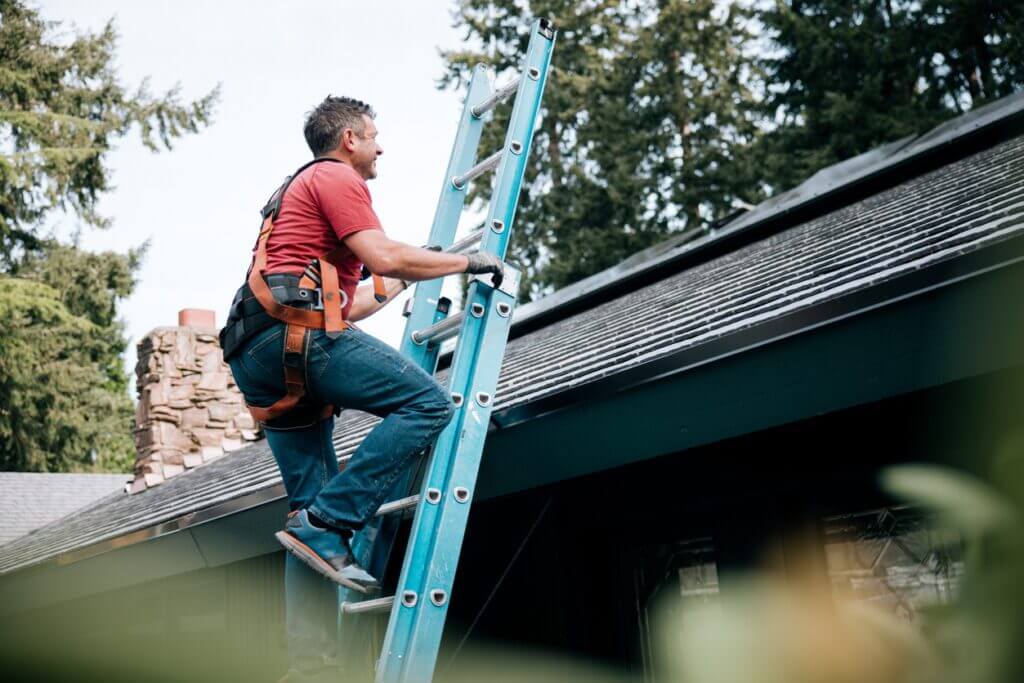
At Mr. Roofer, we know how stressful a roof leak can be, especially when you’re scrambling to protect your home after a storm or sudden ceiling stain. That’s why our process is designed to be clear, responsive, and focused on long-term solutions. Here’s what you can expect when you choose us for leak repair in the Atlanta area.
Step 1: Local Inspection With Photos and Damage Documentation
Every leak tells a story, and we’re here to read it properly. Our experienced technicians start by conducting a thorough on-site inspection, both on the roof and inside the home (if necessary). We don’t just eyeball the issue. We document it.
You’ll receive:
- Clear photos of the affected areas
- Notes on where the water is entering and why
- Details on underlying causes, not just symptoms
This isn’t a guesswork estimate. It’s a deep dive into the true source of your leak.
Step 2: Transparent Repair Estimate—No Pressure Tactics
After the inspection, we’ll provide a straightforward, written estimate outlining:
- What needs to be fixed
- How we’ll fix it
- How much it’ll cost
We don’t upsell or scare you into a full replacement. Remember, over 70% of our jobs are repairs. You’ll get an honest recommendation based on your roof’s actual condition, no more, no less.
Step 3: Fast Scheduling and Long-Term Workmanship Guarantee
Once you approve the repair, we move quickly, especially if your home is at risk from incoming storms. Our crews are prompt, professional, and trained to work cleanly and efficiently.
Every leak repair comes with:
- Timely scheduling that respects your calendar
- Professional workmanship backed by a written guarantee
- A repair-first mindset designed to preserve your roof and your budget
We stand behind every fix we make, and we’re always just a phone call away if questions arise after the job is done.
Emphasis on Clear Communication and Quality Assurance
Throughout the process, you’ll never be left wondering what’s going on. From your first call to the final walkthrough, we’ll keep you in the loop with:
- Clear timelines and scheduling updates
- Real-time photo documentation (before and after)
- Access to your dedicated project contact
At Mr. Roofer, we’re not just fixing roofs. We’re building trust, one home at a time.
Emergency Roof Leak Repair: What to Do While You Wait
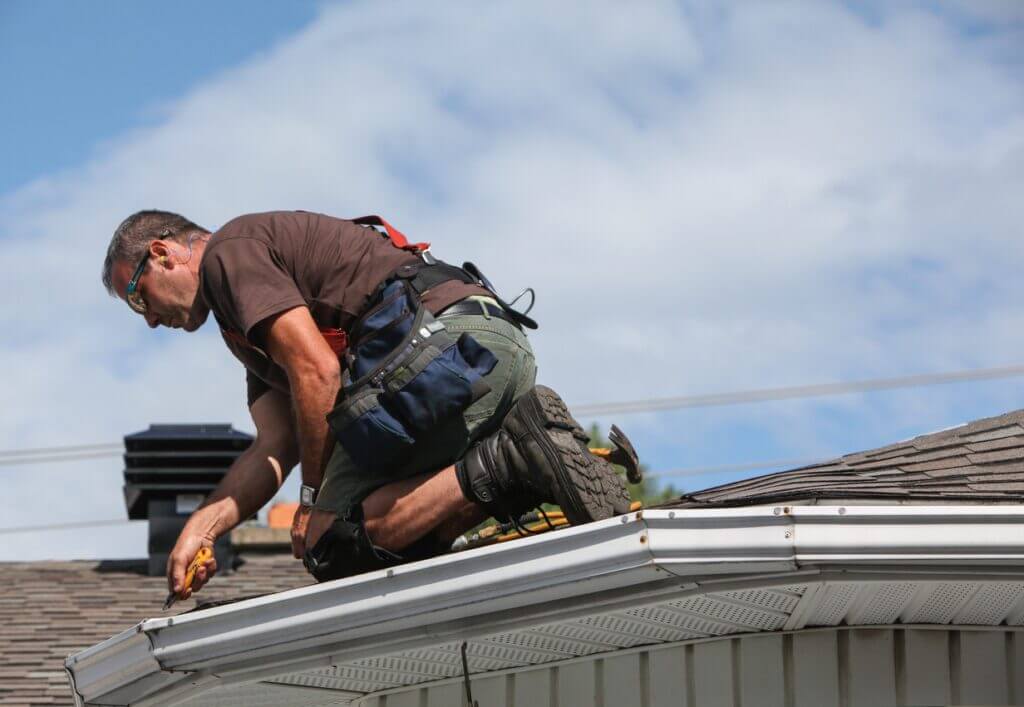
When water is dripping into your living room or running down your walls, every minute feels critical. While waiting for a professional crew to arrive, there are steps you can take to minimize the damage and protect your home. Here’s what Atlanta homeowners should know in a roofing emergency.
Temporary Patching
If it’s safe to access your roof, or even just your attic, there are a few stopgap measures that can help limit the water infiltration until help arrives.
Tarping
A weather-rated tarp is the best temporary roof protection. Secure it with 2x4s, sandbags, or heavy objects at the edges (not nails, which can worsen the damage). Cover a wide enough area to protect both the visible leak and the surrounding roof field. If climbing the roof isn’t safe, avoid it and wait for professionals like Mr. Roofer (we offer emergency tarp services after major storms).
Buckets
Simple but effective: place buckets or large containers under active drips to catch water. Line the bucket with a towel to reduce splashing. For larger leaks, you may need multiple buckets or to empty them frequently.
Attic Checks
If you can safely enter the attic, use flashlights to identify the entry point of the leak. Clear insulation away from wet areas and place a bucket below active drips. If water is pooling on attic flooring, mop it up to prevent ceiling collapse.
Avoiding Further Water Damage Inside the Home
While you can’t stop the rain, you can limit the damage inside:
- Move furniture, rugs, and electronics out of the affected area
- Use towels, blankets, or plastic sheets to absorb or deflect water
- Turn off ceiling lights near water damage to prevent electrical hazards
- Run fans or dehumidifiers to reduce indoor humidity and mold growth
If the ceiling is bulging, use a screwdriver to poke a small drainage hole. This can prevent collapse and direct the water into a controlled bucket setup.
When to Call for Emergency Service vs. Standard Scheduling
Call for emergency service if:
- Water is actively entering your home during a storm
- Ceiling collapse or electrical risk is present
- You have a flat roof with significant ponding or seam failure
- The leak is threatening living spaces or valuables
Standard scheduling may be fine if:
- The leak is small, slow, and not spreading
- The weather is dry, and no immediate rain is forecast
- Temporary patching has stabilized the situation
Don’t Wait—Stop the Drip with Atlanta’s Trusted Leak Repair Experts
A leaking roof isn’t just a nuisance. It’s a warning. Whether you’ve spotted a ceiling stain, heard the telltale drip after a storm, or noticed shingles in your yard, acting fast can mean the difference between a simple fix and major structural repairs.
But not every roofer is equipped (or willing) to tackle complex leak repairs. That’s where Mr. Roofer stands apart. With a repair-first philosophy, deep local expertise, and a reputation for honesty, we help Atlanta homeowners restore peace of mind without the pressure to replace a whole roof when you don’t have to.
From emergency tarping to precision flashing work on 80-year-old homes, we bring the tools, skill, and integrity to do the job right the first time.
Don’t let a small leak become a big problem. Contact Mr. Roofer today for a fast, local inspection and reliable leak repair you can trust.
